La Palma volcano: authorities lock down coastal area as lava approaches sea
By Al Goodman and Hannah Ritchie, CNN
Residents along the eastern shore of Spain's La Palma island were ordered into lockdown Monday as lava flowing from the Cumbre Vieja volcano nears the sea.

By Al Goodman and Hannah Ritchie, CNN
Residents along the eastern shore of Spain's La Palma island were ordered into lockdown Monday as lava flowing from the Cumbre Vieja volcano nears the sea.

Lava flows approaching houses as the Mount Cumbre Vieja erupts in El Paso, spewing out columns of smoke, ash and lava as seen from Los Llanos de Aridane on the Canary island of La Palma, on September 19, 2021. - The Cumbre Vieja volcano erupted on Spain's Canary Islands today spewing out lava, ash and a huge column of smoke after days of increased seismic activity, sparking evacuations of people living nearby, authorities said. Cumbre Vieja straddles a ridge in the south of La Palma island and has erupted twice in the 20th century, first in 1949 then again in 1971.
(Photo by DESIREE MARTIN / AFP) (Photo by DESIREE MARTIN/AFP via Getty Images)
The 1,250 Celsius degree lava may touch the Atlantic Ocean in the hours ahead, likely causing explosions and sending clouds of toxic gases over the island, Canary Islands emergency services warned on Monday morning.
"Given the possibility the lava will reach the sea in the coming hours on the coastal area of Tazacorte, and in anticipation of possible emissions of gas harmful to health, the Canary Islands volcano emergency committee orders the lockdown of San Borondon, Marina Alta, Marina Baja and La Condesa," they tweeted.
"The population should follow instructions of the authorities and remain at home, with doors and windows closed, until the situation can be evaluated in the morning," they added.
In the early hours of Monday morning, the lava traveled past the southwestern town of Todoque which was evacuated a few days ago and was just 1.6 kilometers (roughly 1 mile) from La Palma's coast, according to emergency services.
Authorities have also called on residents within a 5-kilometer radius of the volcano to put in place further precautions, due to the possibility of new explosive eruptions which could cause glass to shatter.
The main airline for the Canary Islands, Binter Canarias, confirmed Monday that it will continue to suspend flights to and from La Palma airport while it monitors the situation.
All other air traffic at the airport was also canceled Monday morning, according to Spain's airport operator, AENA.
Monday is the ninth consecutive day of eruptions from the volcano, which has so far forced the evacuation of nearly 6,000 people, destroyed hundreds of homes and ravaged the island's economically crucial banana plantations.
Reuters drone footage showed a rapid river of red hot lava flowing down the slopes of the crater, passing close to homes, and swathes of land and buildings engulfed by a black mass of slower-moving, older lava.
The flow of lava has engulfed more than 230 hectares, the European Union satellite monitoring service Copernicus said, swallowing hundreds of houses as well as roads, schools and churches, and forcing thousands to evacuate.
No fatalities or serious injuries have been reported since the volcano's eruption, but about 15% of the island's banana crop could be at risk, jeopardizing thousands of jobs.
The 1,250 Celsius degree lava may touch the Atlantic Ocean in the hours ahead, likely causing explosions and sending clouds of toxic gases over the island, Canary Islands emergency services warned on Monday morning.
"Given the possibility the lava will reach the sea in the coming hours on the coastal area of Tazacorte, and in anticipation of possible emissions of gas harmful to health, the Canary Islands volcano emergency committee orders the lockdown of San Borondon, Marina Alta, Marina Baja and La Condesa," they tweeted.
"The population should follow instructions of the authorities and remain at home, with doors and windows closed, until the situation can be evaluated in the morning," they added.
In the early hours of Monday morning, the lava traveled past the southwestern town of Todoque which was evacuated a few days ago and was just 1.6 kilometers (roughly 1 mile) from La Palma's coast, according to emergency services.
Authorities have also called on residents within a 5-kilometer radius of the volcano to put in place further precautions, due to the possibility of new explosive eruptions which could cause glass to shatter.
The main airline for the Canary Islands, Binter Canarias, confirmed Monday that it will continue to suspend flights to and from La Palma airport while it monitors the situation.
All other air traffic at the airport was also canceled Monday morning, according to Spain's airport operator, AENA.
Monday is the ninth consecutive day of eruptions from the volcano, which has so far forced the evacuation of nearly 6,000 people, destroyed hundreds of homes and ravaged the island's economically crucial banana plantations.
Reuters drone footage showed a rapid river of red hot lava flowing down the slopes of the crater, passing close to homes, and swathes of land and buildings engulfed by a black mass of slower-moving, older lava.
The flow of lava has engulfed more than 230 hectares, the European Union satellite monitoring service Copernicus said, swallowing hundreds of houses as well as roads, schools and churches, and forcing thousands to evacuate.
No fatalities or serious injuries have been reported since the volcano's eruption, but about 15% of the island's banana crop could be at risk, jeopardizing thousands of jobs.
La Palma volcano: Explosions send lava tumbling down mountainside after brief lull
Sep 27, 2021
Global News
Lava exploded from La Palma's volcano on Monday as night fell on the Spanish island after a brief lull, while hundreds of people in coastal villages hunkered down in anticipation of lava emitted in previous days reaching the sea and releasing toxic gas.
Spurts of vivid red lava emerged from the Cumbre Vieja volcano in the early evening and snaked down the dark mountainside towards evacuated buildings after a period of several hours without explosions.
No fatalities or serious injuries have been reported, but about 15% of the island's banana crop could be at risk, jeopardizing thousands of jobs.
Scientists: Spanish volcano has entered 'low activity' phase
LOS LLANOS DE ARIDANE, Canary Islands (AP) — A Spanish island volcano that has buried more than 500 buildings and displaced over 6,000 people since last week lessened its activity on Monday, although scientists warned that it was too early to declare the eruption phase finished and authorities ordered residents to stay indoors to avoid the unhealthy fumes from lava meeting sea waters.
LOS LLANOS DE ARIDANE, Canary Islands (AP) — A Spanish island volcano that has buried more than 500 buildings and displaced over 6,000 people since last week lessened its activity on Monday, although scientists warned that it was too early to declare the eruption phase finished and authorities ordered residents to stay indoors to avoid the unhealthy fumes from lava meeting sea waters.

© Provided by The Canadian Press
The plume of ash emerging from the main vent that opened on Sept. 19. stopped in the early hours of Monday, live footage of the Cumbre Vieja range in the La Palma island broadcasted by the public Canary Islands Television showed. But the column of ash and volcanic material returned after a two-hour hiatus.
“The volcano of La Palma has entered in a phase of lower activity,” the Madrid-based Institute of Geosciences, IGEO, said in a tweet. “Let's see how it evolves in the coming hours.”
The archipelago's volcanology institute published graphs showing a sharp decline in seismic activity in the area. “In the last hours the volcanic tremor has almost disappeared, as well as the strombolian explosive activity,” Involcan said on Twitter. But the institute had to follow later with another post announcing that, in addition to the ash cloud, “the re-emission of lava in the main cone is also confirmed.”
Experts were also on alert as the swarm of quakes that preceded and accompanied Spain's first volcanic eruption on land in half a century moved south, with more activity detected in the island's Fuencaliente area, Spain's National Geographic Institute said.
“That the volcano is now less active doesn't mean that it cannot change,” the institute's top investigator, Stavros Meletlidis, told Antena 3, a private Spanish broadcaster.
Meanwhile, the island's authorities advised residents in four neighborhoods to remain indoors to avoid toxic gases that could be released as a result of lava at more than 1,000 degrees Celsius (1,830 Fahrenheit) meeting Atlantic Ocean water at a temperature of around 20 degrees Celsius.
Scientists say that the thermal shock results in the release of water vapor plumes loaded with hydrochloric acid and tiny particles of volcanic glass that can cause skin, eye and respiratory tract irritation.
Shopkeepers and residents were also sweeping the layer of ash that had fallen over the island's capital, Santa Cruz de Las Palmas, after winds dispersed the volcano's cloud the day before.
The speed of the flow had increased since Sunday as a result of more fluid lava descending down a sharp slope toward cliffs onto the sea. The flow was some 800 meters from reaching the water early on Monday, authorities said.
More than 230 hectares have been buried by the lava, which has destroyed over 18 kilometers of roads, according to Copernicus, the EU's satellite monitoring service. The molten rock has destroyed houses, schools, churches and health centers, as well as irrigation infrastructure for the island's banana plantations, which provide nearly one-third of the island's jobs.
No fatalities or serious injuries have been reported since the volcano’s eruption.
La Palma, home to about 85,000, is part of the volcanic Canary Islands, an archipelago off northwest Africa. The island is roughly 35 kilometers (22 miles) long and 20 kilometers (12 miles) wide at its broadest point.
__
Parra reported from Madrid.
Daniel Roca And Aritz Parra, The Associated Press
The plume of ash emerging from the main vent that opened on Sept. 19. stopped in the early hours of Monday, live footage of the Cumbre Vieja range in the La Palma island broadcasted by the public Canary Islands Television showed. But the column of ash and volcanic material returned after a two-hour hiatus.
“The volcano of La Palma has entered in a phase of lower activity,” the Madrid-based Institute of Geosciences, IGEO, said in a tweet. “Let's see how it evolves in the coming hours.”
The archipelago's volcanology institute published graphs showing a sharp decline in seismic activity in the area. “In the last hours the volcanic tremor has almost disappeared, as well as the strombolian explosive activity,” Involcan said on Twitter. But the institute had to follow later with another post announcing that, in addition to the ash cloud, “the re-emission of lava in the main cone is also confirmed.”
Experts were also on alert as the swarm of quakes that preceded and accompanied Spain's first volcanic eruption on land in half a century moved south, with more activity detected in the island's Fuencaliente area, Spain's National Geographic Institute said.
“That the volcano is now less active doesn't mean that it cannot change,” the institute's top investigator, Stavros Meletlidis, told Antena 3, a private Spanish broadcaster.
Meanwhile, the island's authorities advised residents in four neighborhoods to remain indoors to avoid toxic gases that could be released as a result of lava at more than 1,000 degrees Celsius (1,830 Fahrenheit) meeting Atlantic Ocean water at a temperature of around 20 degrees Celsius.
Scientists say that the thermal shock results in the release of water vapor plumes loaded with hydrochloric acid and tiny particles of volcanic glass that can cause skin, eye and respiratory tract irritation.
Shopkeepers and residents were also sweeping the layer of ash that had fallen over the island's capital, Santa Cruz de Las Palmas, after winds dispersed the volcano's cloud the day before.
The speed of the flow had increased since Sunday as a result of more fluid lava descending down a sharp slope toward cliffs onto the sea. The flow was some 800 meters from reaching the water early on Monday, authorities said.
More than 230 hectares have been buried by the lava, which has destroyed over 18 kilometers of roads, according to Copernicus, the EU's satellite monitoring service. The molten rock has destroyed houses, schools, churches and health centers, as well as irrigation infrastructure for the island's banana plantations, which provide nearly one-third of the island's jobs.
No fatalities or serious injuries have been reported since the volcano’s eruption.
La Palma, home to about 85,000, is part of the volcanic Canary Islands, an archipelago off northwest Africa. The island is roughly 35 kilometers (22 miles) long and 20 kilometers (12 miles) wide at its broadest point.
__
Parra reported from Madrid.
Daniel Roca And Aritz Parra, The Associated Press
The eruption of a volcano in the Canary Islands has so far led to the destruction of homes and evacuations on the small Spanish island of La Palma, with fears that the eruption could trigger a tsunami
By Liv McMahon
Monday, 27th September 2021
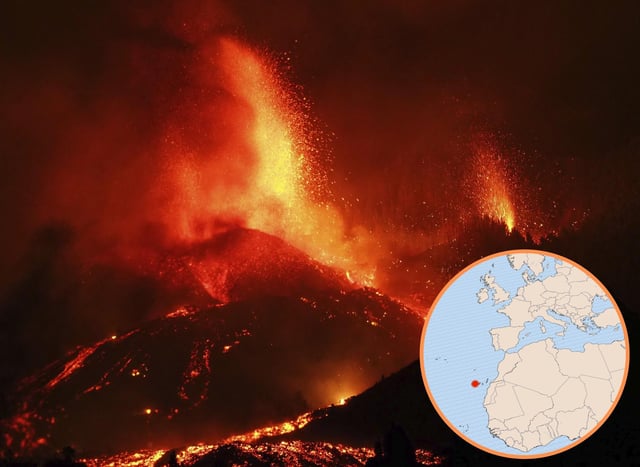
La Palma volcano: Where is La Palma? Map shows where the Canary Islands volcano eruption is - and will it cause a tsunami?
(Image credit: AP/Canva Pro)
A volcano located on the Canary Island of La Palma erupted on Sunday 19 September, sending lava streaming down hills and destroying hundreds of homes on the volcanic island.
5,000 people were initially evacuated from La Palma area surrounding the Cumbre Vieja volcano, but thousands more have been evacuated following the eruption of a new vent on the Canary Islands volcanic ridge.
La Palma’s airport was previously forced to close amid the disruption, but has now reopened.
The huge ash cloud accumulating over the island has once again seen flights from La Palma cancelled, however.
Here's what caused the Canary Islands volcanic eruption, where the volcano is located and how long the eruption could last.
Where is La Palma?
One of Spain’s seven Canary Islands, La Palma is the most northwesterly islands of the chain of volcanic islands like Tenerife, Fuerteventura, Gran Canaria and Lanzarote.
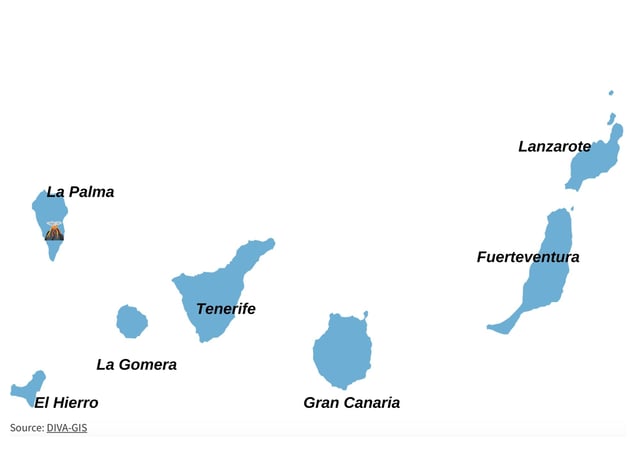
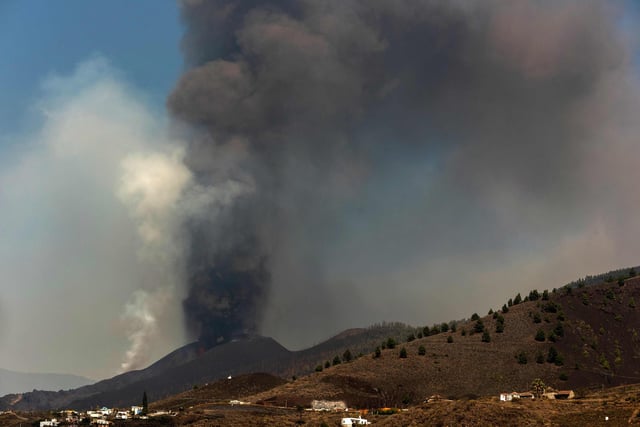
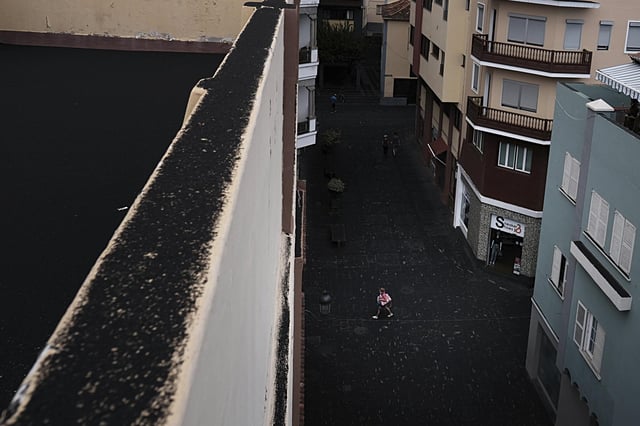
A volcano located on the Canary Island of La Palma erupted on Sunday 19 September, sending lava streaming down hills and destroying hundreds of homes on the volcanic island.
5,000 people were initially evacuated from La Palma area surrounding the Cumbre Vieja volcano, but thousands more have been evacuated following the eruption of a new vent on the Canary Islands volcanic ridge.
La Palma’s airport was previously forced to close amid the disruption, but has now reopened.
The huge ash cloud accumulating over the island has once again seen flights from La Palma cancelled, however.
Here's what caused the Canary Islands volcanic eruption, where the volcano is located and how long the eruption could last.
Where is La Palma?
One of Spain’s seven Canary Islands, La Palma is the most northwesterly islands of the chain of volcanic islands like Tenerife, Fuerteventura, Gran Canaria and Lanzarote.

The island of La Palma is the most northwestern of the Canary Islands, with the Cumbre Vieja volcano erupting on the south of the fifth-largest island (Image credit: Canva Pro)
La Palma is the fifth largest of the islands, with an estimated area of 7,493km squared.
A popular tourist destination for snorkelling, and known for its rugged, rocky landscape, La Palma has a population of roughly 85,000 people.
The volcanic eruption on Sunday took place at the Cumbre Vieja volcano on the southwest of the Canary island.
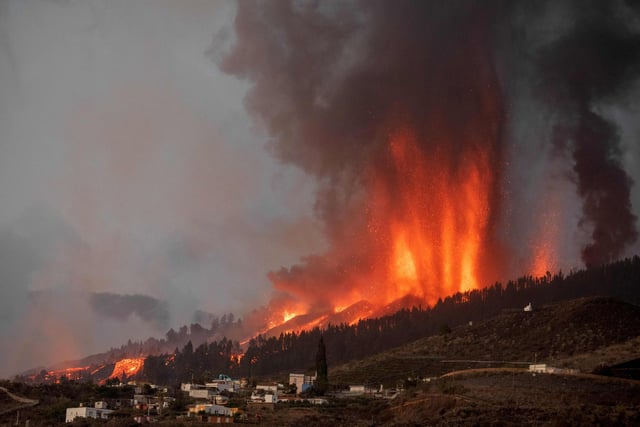
La Palma is the fifth largest of the islands, with an estimated area of 7,493km squared.
A popular tourist destination for snorkelling, and known for its rugged, rocky landscape, La Palma has a population of roughly 85,000 people.
The volcanic eruption on Sunday took place at the Cumbre Vieja volcano on the southwest of the Canary island.

Mount Cumbre Vieja erupts in El Paso, spewing out columns of smoke, ash and lava as seen from Los Llanos de Aridane on the Canary island of La Palma on September 19, 2021. (Image credit: Desiree Martin/AFP via Getty Images)
What caused La Palma’s volcanic eruption?
The Canary Islands volcanic eruption took place following a swarm of earthquakes and tremors which have been rocking the island over the last two weeks.
A total of 642 quakes measuring between magnitude 2.0 and 3.0 were recorded on and around the island of La Palma during the last 14 days.
The dramatic eruption on Sunday 19 September is believed to have been triggered by a 4.2 magnitude earthquake striking the islands off Africa’s northwest coast.
What caused La Palma’s volcanic eruption?
The Canary Islands volcanic eruption took place following a swarm of earthquakes and tremors which have been rocking the island over the last two weeks.
A total of 642 quakes measuring between magnitude 2.0 and 3.0 were recorded on and around the island of La Palma during the last 14 days.
The dramatic eruption on Sunday 19 September is believed to have been triggered by a 4.2 magnitude earthquake striking the islands off Africa’s northwest coast.

The Cumbre Vieja volcano spews lava, ash and smoke as seen from Los Llanos de Aridane on the Canary island of La Palma in September 26, 2021.
(Image credit: Desiree Martin/AFP via Getty Images)
Cumbre Vieja started to erupt at 3.15pm local time on Sunday after having last erupted in 1971.
Spanish Tourism Minister Reyes Maroto came under fire for comments calling the eruption a “wonderful show” and potential attraction for tourists.
How long could the La Palma volcano eruption last?
Volcanic eruptions can last between anywhere from days to months.
A volcano eruption at Iceland’s Mount Fagradalsfjall, to the southwest of Reykjavik, is the longest to occur in half a century.
Having begun on 16 March 2021, the Icelandic volcanic eruption will have lasted for six months as of Sunday 26 September.
Cumbre Vieja started to erupt at 3.15pm local time on Sunday after having last erupted in 1971.
Spanish Tourism Minister Reyes Maroto came under fire for comments calling the eruption a “wonderful show” and potential attraction for tourists.
How long could the La Palma volcano eruption last?
Volcanic eruptions can last between anywhere from days to months.
A volcano eruption at Iceland’s Mount Fagradalsfjall, to the southwest of Reykjavik, is the longest to occur in half a century.
Having begun on 16 March 2021, the Icelandic volcanic eruption will have lasted for six months as of Sunday 26 September.

A woman walks down the street covered in ash from the volcano in Santa Cruz de la Palma on the Canary island of La Palma, Spain on Sunday Sept. 26, 2021
. (Image credit: AP/Daniel Roca)
The Canary Islands has historically seen plenty of volcanic activity, with an underwater submarine eruption occurring in waters off the island of El Hierro in 2011.
Could the La Palma volcano eruption cause a tsunami?
The Cumbre Vieja volcano is at risk of collapse should a volcanic eruption occur at the summit of the previously dormant volcanic ridge.
In the early 2000s, University College London scientists studied the volcano's destructive potential, finding that an eruption could trigger a dramatic landslide and consequent ‘mega tsunami’.
Scientists have also said that the risk of such a seismic shift and chances of triggering a tsunami rippling out across the Atlantic and potentially reaching the shores of the United States is small, however.
Dr Isobel Yeo, volcanologist at the UK’s National Oceanography Centre (NOC) said: “The eruptions have caused a great deal of local damage but the current level of seismic activity from magma rising and the eruptions is not something that we would expect to trigger a landslide and cause a mega tsunami in the future.
"Large-scale landslides and tsunami are very infrequent in the Canary Islands and their direct links to eruptions remain uncertain.
"However, the Canary Islands monitoring organisation, Involcan, will be keeping a close eye on the eruption and monitoring the events in the coming days.”
Dr Yeo added that theories of a potential collapse at Cumbre Vieja causing a landslide or ‘mega-tsunami’ would represent “an absolute worst-case scenario” and would be highly unlikely event during the current eruption.
“The "mega-tsunami" hypothesis needs a huge volume landslide,” Dr Yeo said.
“In my opinion, the current level of volcanism is not of sufficient magnitude to create the ground movement required to trigger such a landslide, nor is the type of slide required typical for this region.
“Although the current fountaining and lava flows have been destructive, there would likely have to be a substantial increase in explosivity or increase in the rate of lava expulsion that could spell a change in the dynamics on the island.
"While this is a possibility that we cannot rule out, it is very unlikely that a mega-tsunami will occur during the current unrest.”
A message from the Editor:
Thank you for reading this article. We're more reliant on your support than ever as the shift in consumer habits brought about by coronavirus impacts our advertisers.
If you haven't already, please consider supporting our trusted, fact-checked journalism by taking out a digital subscription.
The Canary Islands has historically seen plenty of volcanic activity, with an underwater submarine eruption occurring in waters off the island of El Hierro in 2011.
Could the La Palma volcano eruption cause a tsunami?
The Cumbre Vieja volcano is at risk of collapse should a volcanic eruption occur at the summit of the previously dormant volcanic ridge.
In the early 2000s, University College London scientists studied the volcano's destructive potential, finding that an eruption could trigger a dramatic landslide and consequent ‘mega tsunami’.
Scientists have also said that the risk of such a seismic shift and chances of triggering a tsunami rippling out across the Atlantic and potentially reaching the shores of the United States is small, however.
Dr Isobel Yeo, volcanologist at the UK’s National Oceanography Centre (NOC) said: “The eruptions have caused a great deal of local damage but the current level of seismic activity from magma rising and the eruptions is not something that we would expect to trigger a landslide and cause a mega tsunami in the future.
"Large-scale landslides and tsunami are very infrequent in the Canary Islands and their direct links to eruptions remain uncertain.
"However, the Canary Islands monitoring organisation, Involcan, will be keeping a close eye on the eruption and monitoring the events in the coming days.”
Dr Yeo added that theories of a potential collapse at Cumbre Vieja causing a landslide or ‘mega-tsunami’ would represent “an absolute worst-case scenario” and would be highly unlikely event during the current eruption.
“The "mega-tsunami" hypothesis needs a huge volume landslide,” Dr Yeo said.
“In my opinion, the current level of volcanism is not of sufficient magnitude to create the ground movement required to trigger such a landslide, nor is the type of slide required typical for this region.
“Although the current fountaining and lava flows have been destructive, there would likely have to be a substantial increase in explosivity or increase in the rate of lava expulsion that could spell a change in the dynamics on the island.
"While this is a possibility that we cannot rule out, it is very unlikely that a mega-tsunami will occur during the current unrest.”
A message from the Editor:
Thank you for reading this article. We're more reliant on your support than ever as the shift in consumer habits brought about by coronavirus impacts our advertisers.
If you haven't already, please consider supporting our trusted, fact-checked journalism by taking out a digital subscription.
No comments:
Post a Comment